| Oracle® Fusion Middleware Application Adapter for PeopleSoft User's Guide for Oracle WebLogic Server 11g Release 1 (11.1.1) Part Number E17055-01 |
|
|
View PDF |
| Oracle® Fusion Middleware Application Adapter for PeopleSoft User's Guide for Oracle WebLogic Server 11g Release 1 (11.1.1) Part Number E17055-01 |
|
|
View PDF |
Oracle Application Adapter for PeopleSoft integrates seamlessly with Oracle Business Process Execution Language (BPEL) Process Manager to facilitate Web service integration. Oracle BPEL Process Manager is based on the Service-Oriented Architecture (SOA). It consumes adapter services exposed as Web Service Definition Language (WSDL) documents.
This chapter includes the following topics:
To integrate with Oracle SOA Suite, Oracle Application Adapter for PeopleSoft must be deployed in the same WLS container as Oracle BPEL Process Manager. The underlying adapter services must be exposed as WSDL files, which are generated during design time in Oracle Application Adapter Application Explorer (Application Explorer) for both request-response (outbound) and event notification (inbound) services of the adapter. See Chapter 2, "Configuring Oracle Application Adapter for PeopleSoft" for more information.
The generated WSDL files are used to design the appropriate BPEL processes for inbound or outbound adapter services. A completed BPEL process must be successfully compiled in JDeveloper and deployed to a SOA server. Upon deployment to the SOA server, every newly built process is automatically deployed to the Oracle Enterprise Manager Console, where you run, monitor, and administer BPEL processes, and listen to adapter events.
During installation, Oracle Application Adapter for PeopleSoft is deployed as a J2CA 1.0 resource adapter within the WLS container. The adapter must be deployed in the same WLS container as Oracle BPEL Process Manager.
To configure a new Application Server connection in Oracle JDeveloper:
Open Oracle JDeveloper on your system.
From the menu bar, click View and select Application Server Navigator.
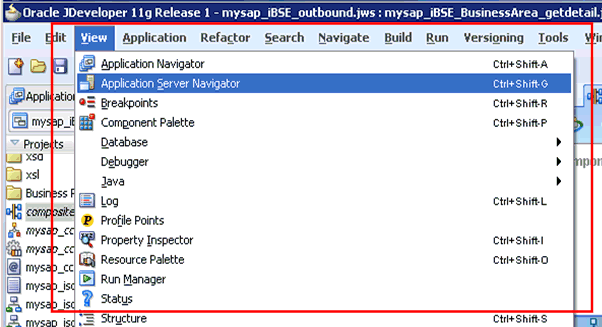
The Application Server tab is displayed.

Right-click Application Servers, and then select New Application Server.
The Create Application Server Connection Wizard is displayed.
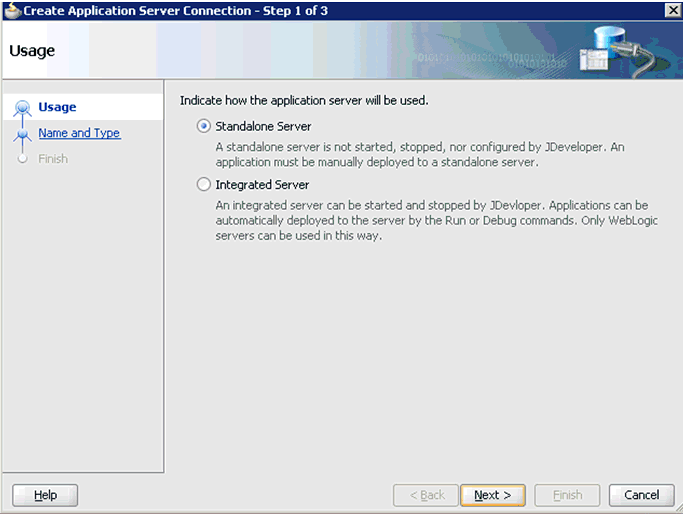
Accept the default selection (Standalone Server) and click Next.
The Name and Type page is displayed.
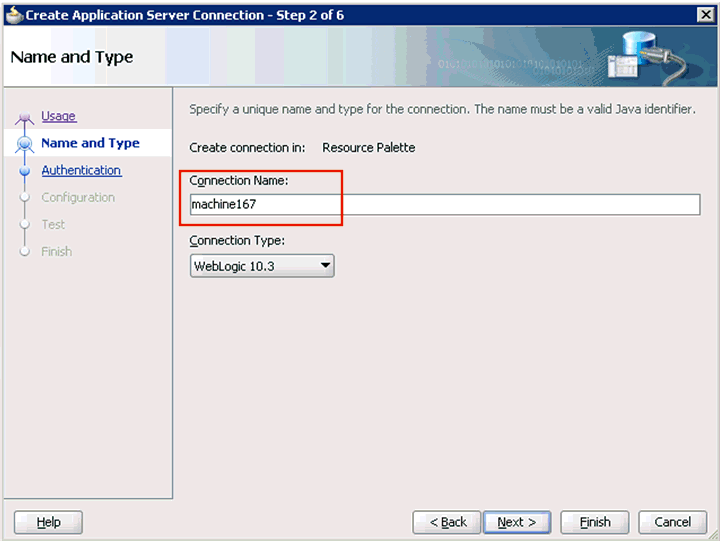
Specify a new name for the Application Server connection and click Next.
The Authentication page is displayed.
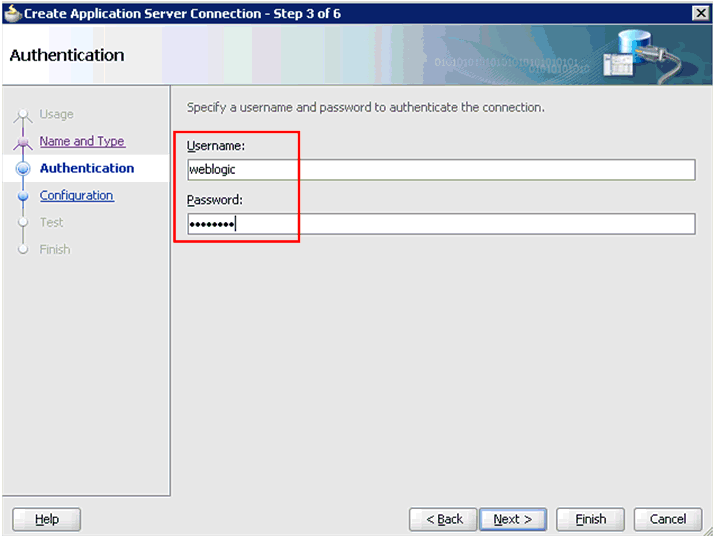
Specify a valid user name (for example, weblogic) and a password (for example, welcome1) for your new connection.
Click Next.
The Configuration page is displayed.
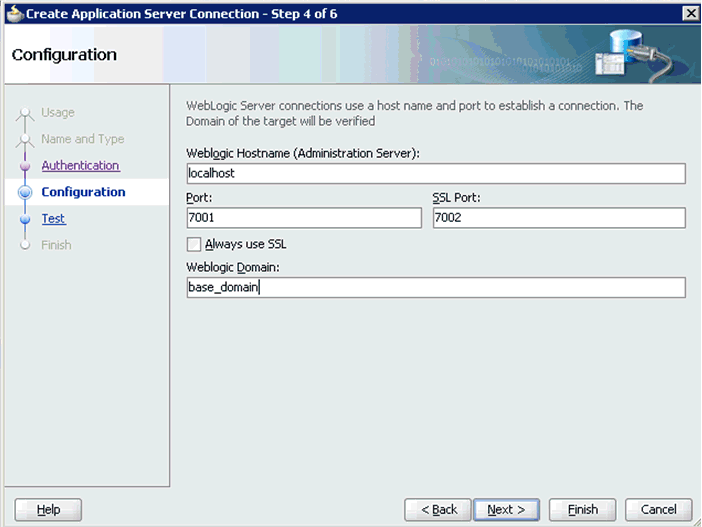
Specify the Oracle WebLogic host name (for example, localhost), which is the machine IP where the process needs to deploy and Oracle WebLogic domain (for example, base_domain).
Click Next.
The Test page is displayed.
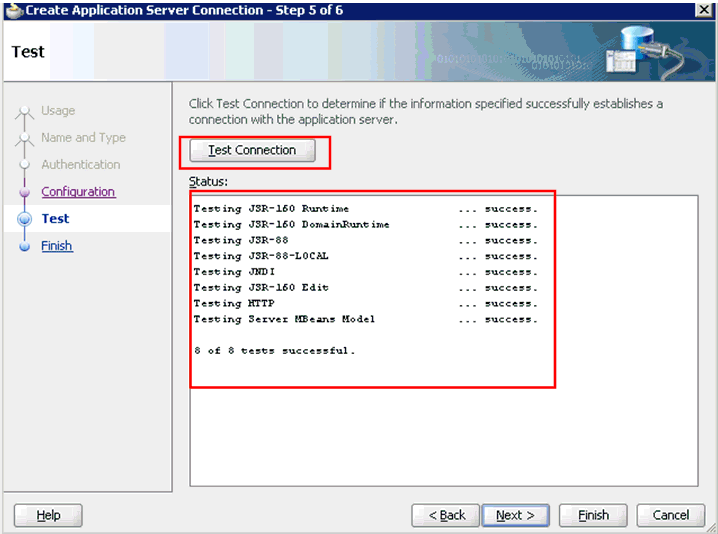
Click Test Connection.
Ensure that the test status is successful.
Click Next.
The Finish page is displayed.
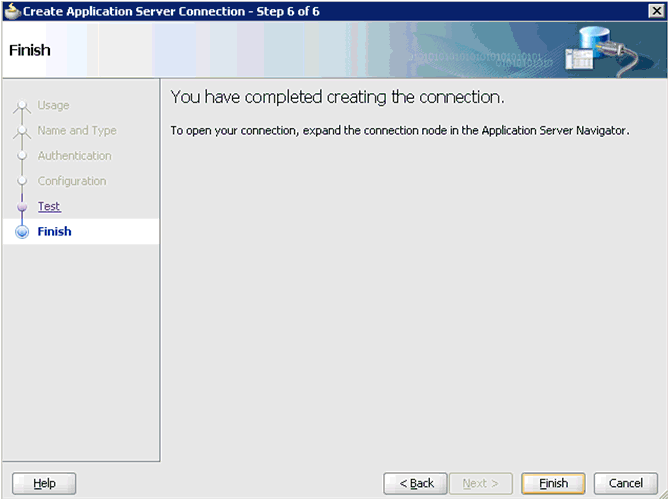
Click Finish.
The new Application Server connection is listed in the left pane (Application Server tab), as shown in the following image.
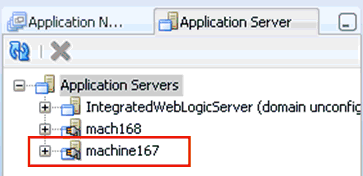
The following tools are required to complete your adapter design-time configuration:
Oracle Adapter Application Explorer (Application Explorer)
Oracle JDeveloper BPEL Designer (JDeveloper) or Eclipse
Note:
The examples in this chapter demonstrate the use of JDeveloper.Before you design a BPEL process, you must create a schema and generate the respective WSDL file using Application Explorer. See "Generating WSDL for Request/Response Service" for more information.
To generate WSDL for outbound interaction in Application Explorer:
Start Application Explorer and connect to a defined PeopleSoft target or create a new target.
See "Defining a Target to PeopleSoft" for more information.
Expand the PeopleSoft target to which you are connected.
Expand Component Interfaces and select LOCATION.
Right-click LOCATION, and then select Create Outbound JCA Service (Request/Response).

The Export WSDL dialog is displayed.

Specify an export location on your file system or accept the default path.
The .wsdl file extension is added automatically. By default, the names of WSDL files generated for request-response services end with _invoke.
Click OK.
You can now create a new SOA application, which is the first step that is required to define a BPEL outbound process in JDeveloper.
Perform the following steps to create a new SOA application for the outbound BPEL process:
Open Oracle JDeveloper on your system.
In the Application Navigator tab, click New Application.
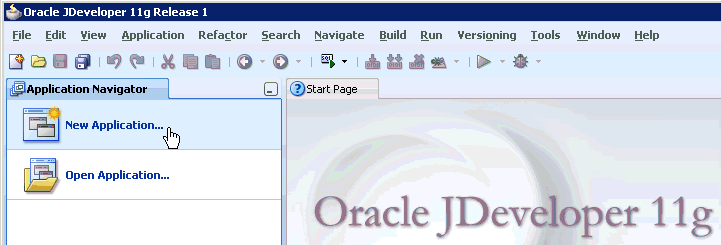
The Create SOA Application wizard is displayed.
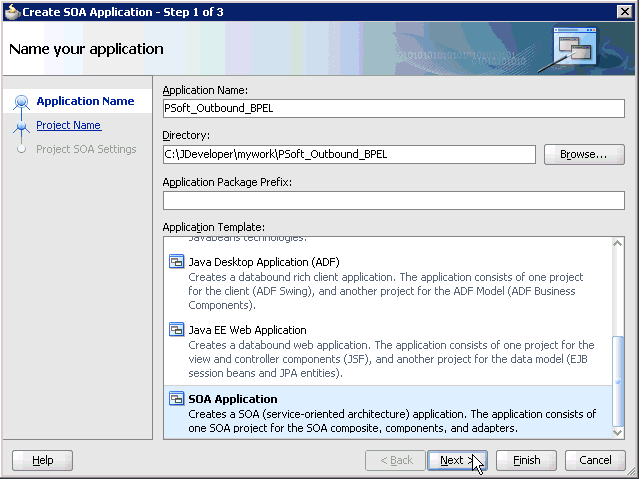
From the Application Template list, click SOA Application.
Enter name for the new SOA application (for example, PSoft_Outbound_BPEL) and click Next.
The Name your project page is displayed.
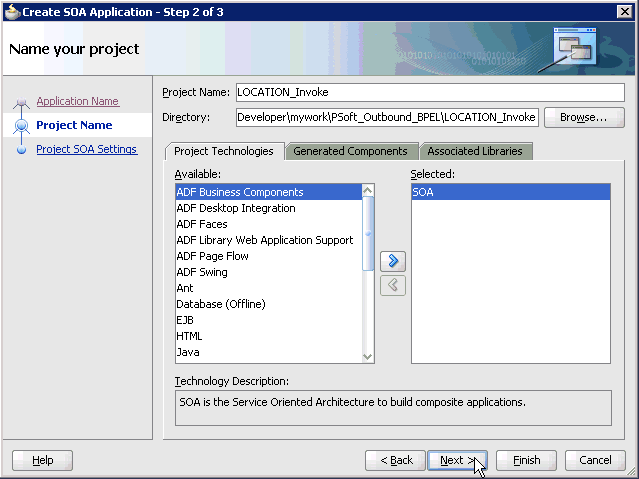
Enter a project name (for example, LOCATION_Invoke) and click Next.
The Configure SOA settings page is displayed.
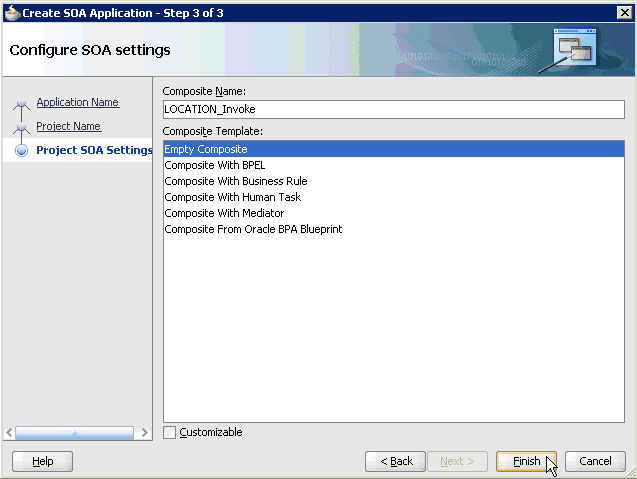
From the Composite Template list, select Empty Composite and click Finish.
The new SOA application (PSoft_Outbound_BPEL) and associated project (LOCATION_Invoke) are added to the Application Navigator tab in the left pane.
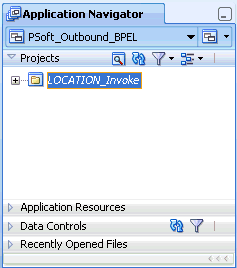
This section describes how to define a BPEL outbound process, which consists of the following stages:
Configuring a Third Party Adapter Service Component
Configuring an Outbound BPEL Process Component
Configuring a Third Party Adapter Service Component
Perform the following steps to create a third party adapter service component:
Drag and drop the Third Party Adapter component from the Component Palette tab (Service Adapters section) to the External References pane.
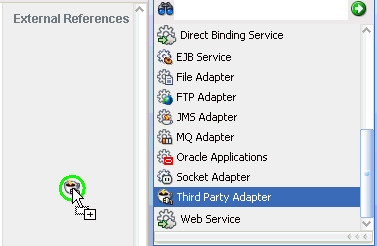
The Create Third Party Adapter Service dialog is displayed.
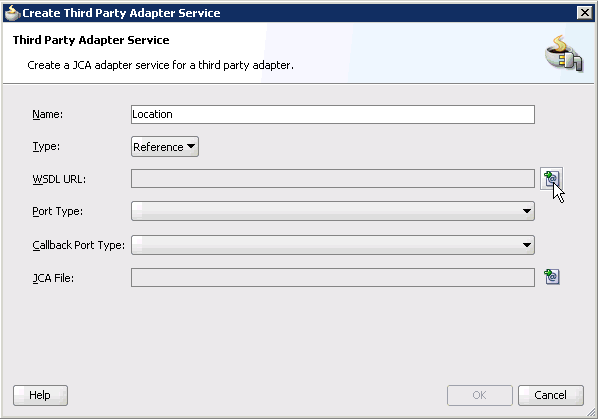
Enter a name for the new third party adapter service.
Ensure that Reference is selected from the Type list (default).
Click the Find existing WSDLs icon, which is located to the right of the WSDL URL field.
The SOA Resource Browser dialog is displayed.
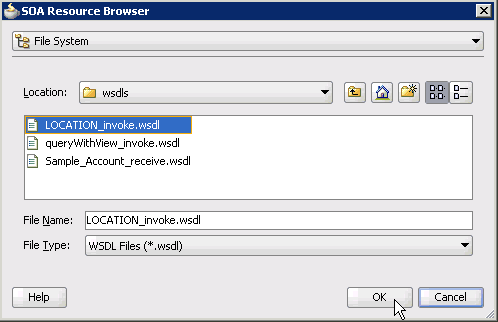
Browse and select an outbound WSDL file (for example, LOCATION_invoke.wsdl) from the following directory:
C:\oracle\Middleware\Oracle_SOA1\soa\thirdparty\ApplicationAdapters\wsdls
Click OK.
The Localize Files dialog is displayed.
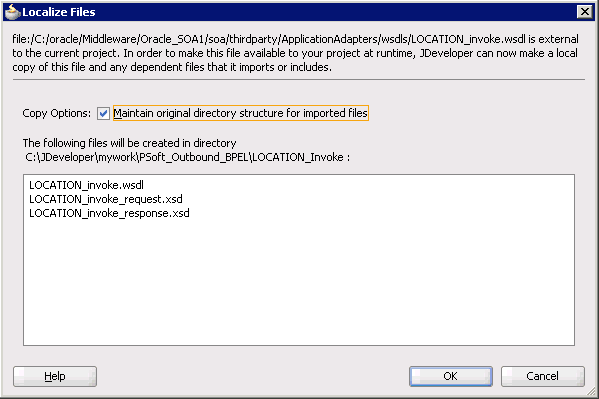
Click OK.
The outbound WSDL file and associated request and response XML schema files (.xsd) are imported to the project folder that has been created.
You are returned to the Create Third Party Adapter Service dialog.
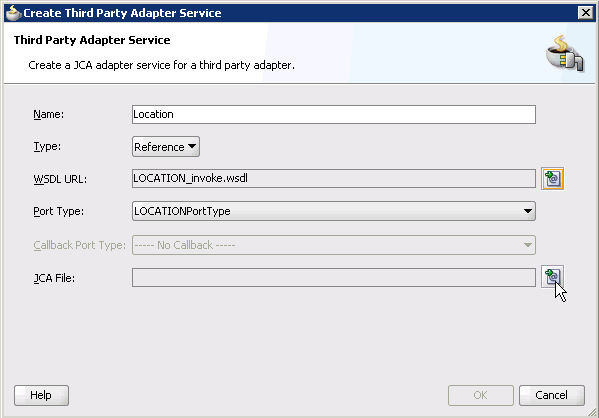
Click the Find JCA Files icon, which is located to the right of the JCA File field.
The SOA Resource Browser dialog is displayed.
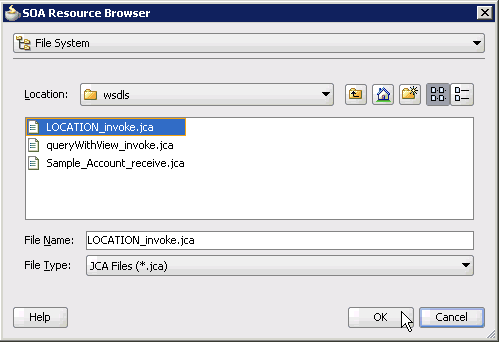
Browse and select the JCA properties file (for example, LOCATION_invoke.jca) from the following directory:
C:\oracle\Middleware\Oracle_SOA1\soa\thirdparty\ApplicationAdapters\wsdls
Click OK.
The following message is displayed.
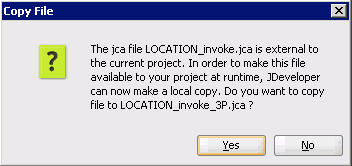
Click Yes.
A copy of the JCA properties file is made in the project folder.
You are returned to the Create Third Party Adapter Service dialog.
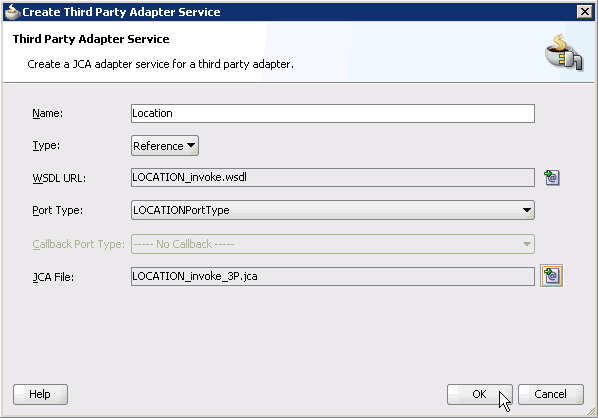
Click OK.
The third party adapter service component (Location) is created in the External References pane, as shown in the following image.
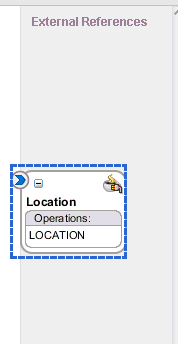
You are now ready to configure an outbound BPEL process component.
Configuring an Outbound BPEL Process Component
Perform the following steps to configure an outbound BPEL process component:
Drag and drop the BPEL Process component from the Component Palette tab (Service Components section) to the Components pane.
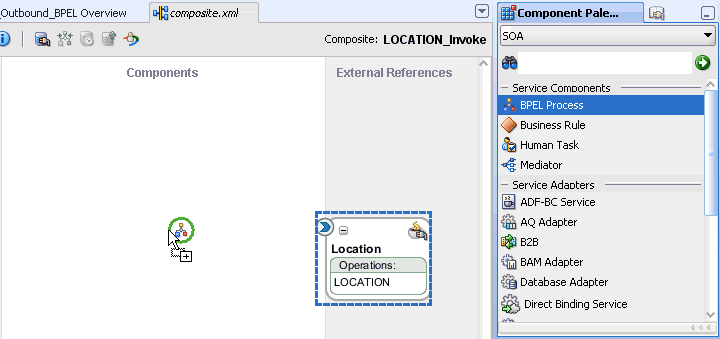
The Create BPEL Process dialog is displayed.
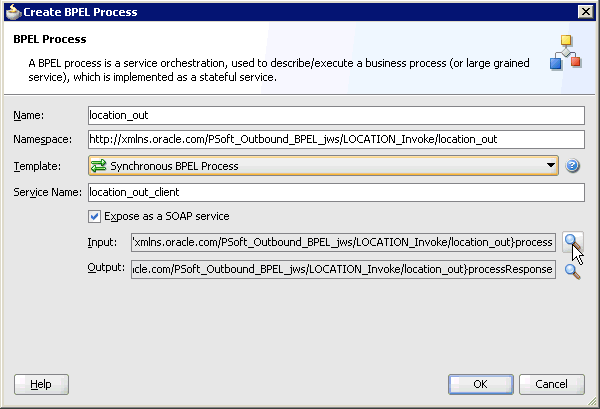
In the Name field, enter a name to identify the new outbound BPEL process component (for example, location_out).
From the Template list, select Synchronous BPEL Process.
Click the Browse Input Elements icon, which is located to the right of the Input field to select the associated XML request schema file.
The Type Chooser dialog is displayed.
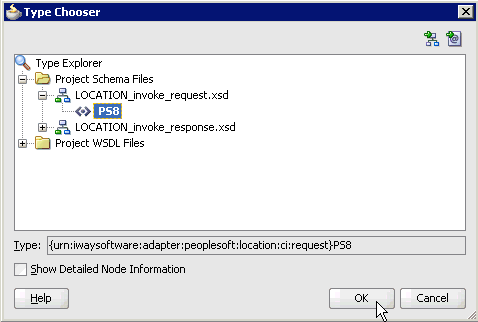
Expand Project Schema Files, LOCATION_invoke_request.xsd, and select PS8.
Click OK.
You are returned to the Create BPEL Process dialog.
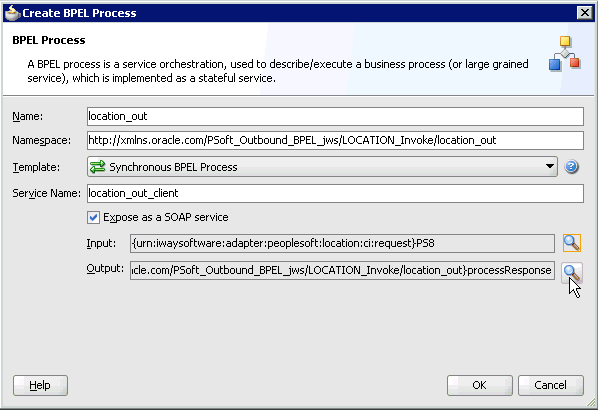
Click the Browse Output Elements icon, which is located to the right of the Output field to select the associated XML response schema file.
The Type Chooser dialog is displayed.
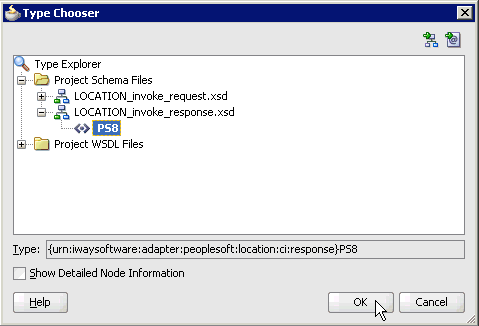
Expand Project Schema Files, LOCATION_invoke_response.xsd, and select PS8.
Click OK.
You are returned to the Create BPEL Process dialog.
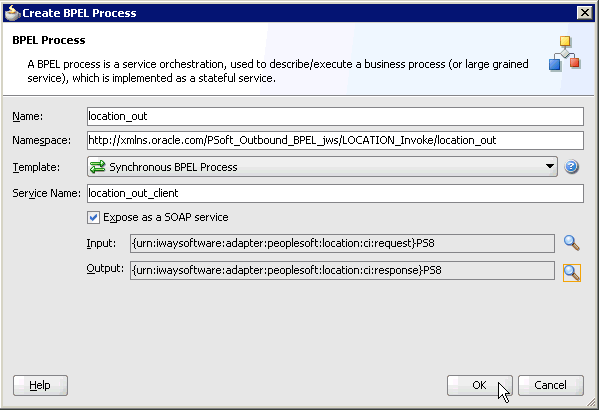
Click OK.
Create a connection between the outbound BPEL process component (location_out) and the third party adapter service component (Location).
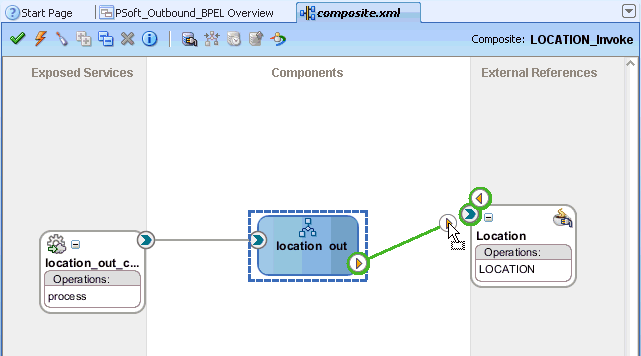
Double-click the outbound BPEL process component (location_out) in the Components pane.
The following is displayed.
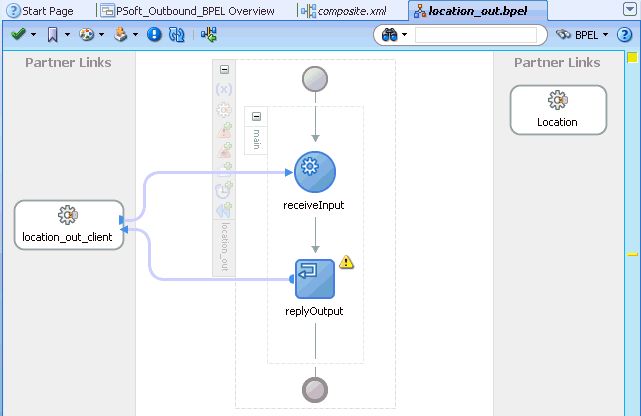
Drag and drop the Invoke activity component to the Components pane and place it between the receiveInput activity component and the replyOutput activity component.
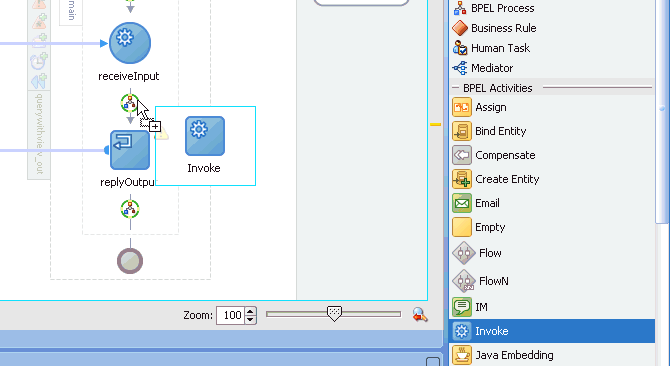
Create a connection between the new Invoke activity component (Invoke_1) and the third party adapter service component (Location).
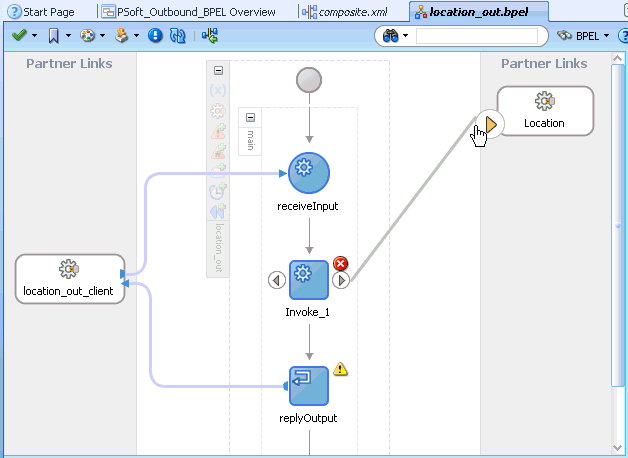
The Edit Invoke dialog is displayed.
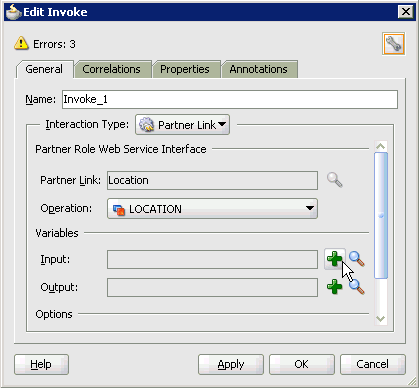
Click the Automatically Create Input Variable icon, which is located to the right of the Input field to configure a new input variable.
The Create Variable dialog is displayed.
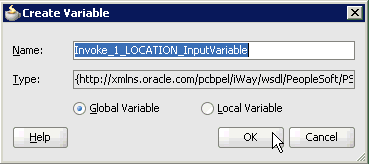
Accept the default values that are provided for the new input variable and click OK.
You are returned to the Edit Invoke dialog.
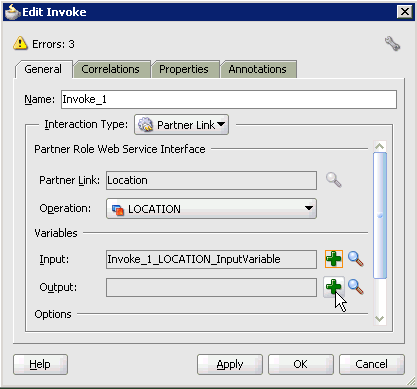
Click the Automatically Create Output Variable icon, which is located to the right of the Output field to configure a new output variable.
The Create Variable dialog is displayed.
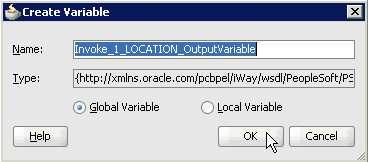
Accept the default values that are provided for the new output variable and click OK.
You are returned to the Edit Invoke dialog.
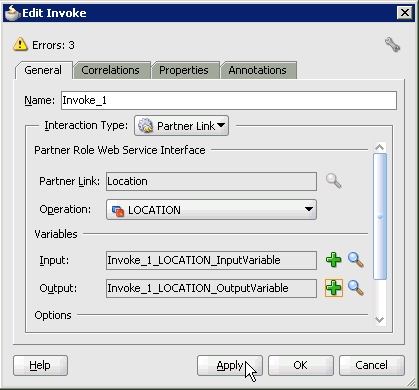
Click Apply and then OK.
The Invoke activity component (Invoke_1) is updated accordingly.
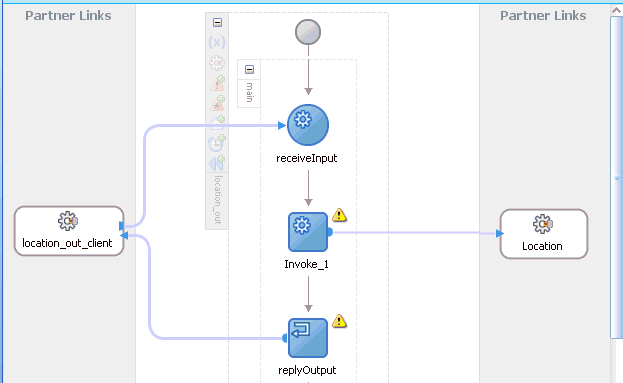
Drag and drop the Assign activity component to the Components pane and place it between the Receive activity component (receiveInput) and the Invoke activity component (Invoke_1).
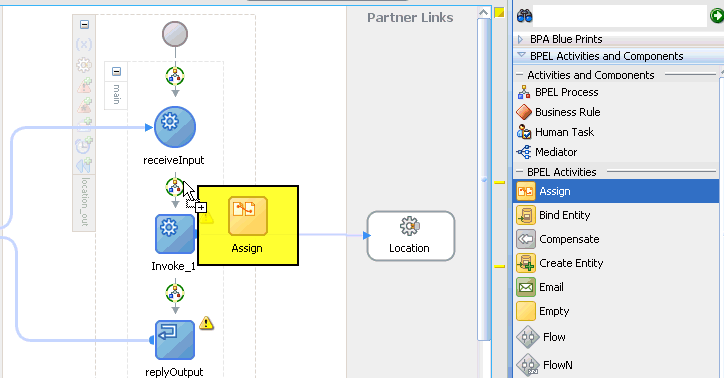
Double-click the new Assign activity component (Assign_1).
The Assign dialog is displayed.
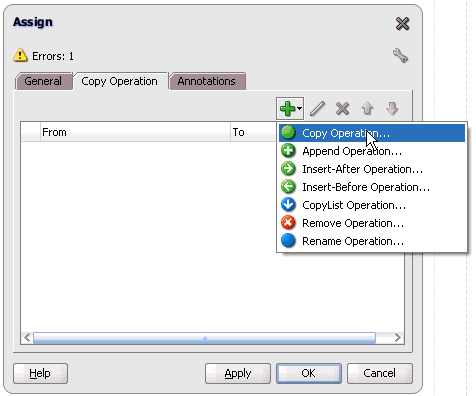
Click the Copy Operation tab.
Click the Plus sign icon and select Copy Operation from the list of available operations.
The Create Copy Operation dialog is displayed.
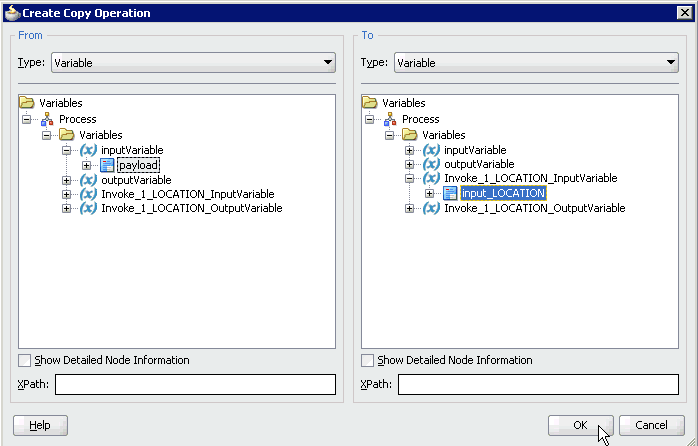
In the From pane, expand Variables, InputVariable, and then select payload.
In the To pane, expand Variables, Invoke_1_LOCATION_InputVariable, and then select input_LOCATION.
Click OK.
You are returned to the Assign dialog.
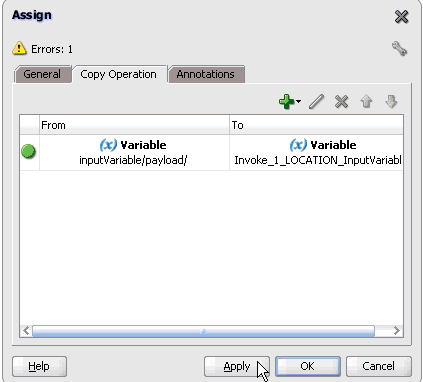
Click Apply and then OK.
Drag and drop the Assign activity component to the Components pane and place it between the Invoke activity (Invoke_1) and the Reply activity (replyOutput).
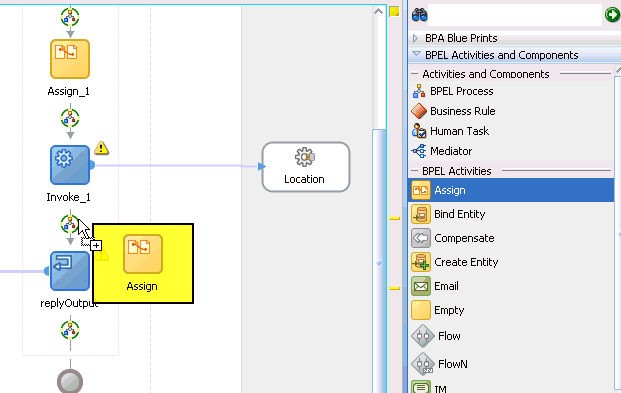
Double-click the new Assign activity component (Assign_2).
The Assign dialog is displayed.

Click the Copy Operation tab.
Click the Plus sign icon and select Copy Operation from the list of available operations.
The Create Copy Operation dialog is displayed.
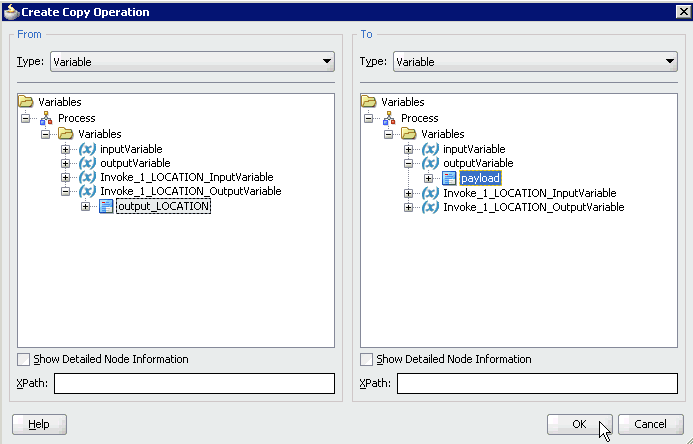
In the From pane, expand Variables, Invoke_1_LOCATION_OutputVariable, and then select output_LOCATION.
In the To pane, expand Variables, outputVariable, and then select payload.
Click OK.
You are returned to the Assign dialog.
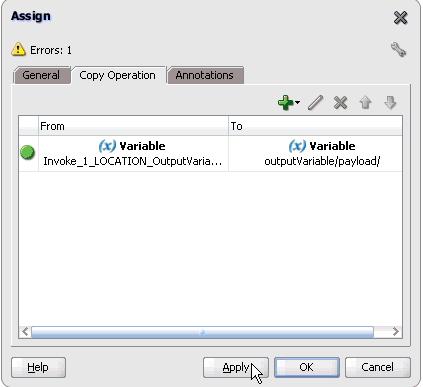
Click Apply and then OK.
The completed activity flow is now displayed.
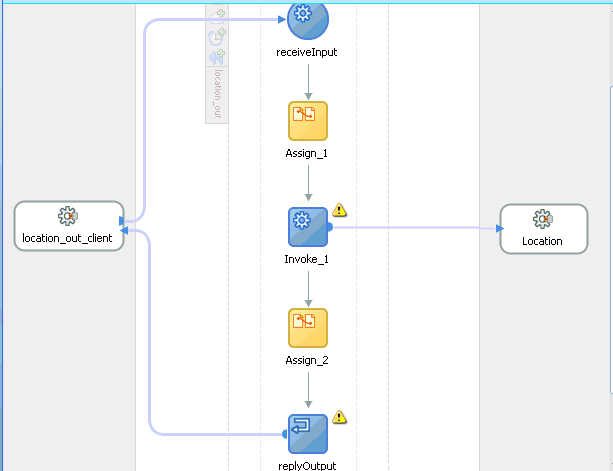
Double-click composite.xml in the left pane.
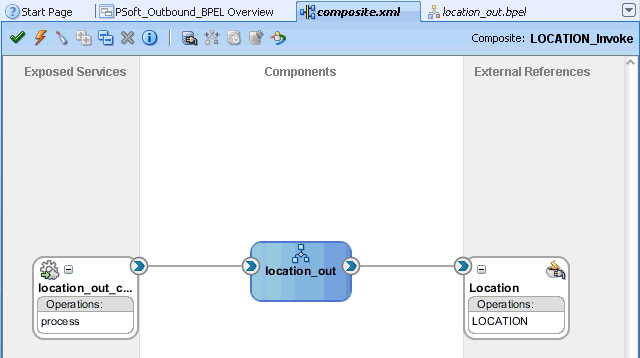
Click the Save All icon in the menu bar to save the new outbound BPEL process component that was configured.
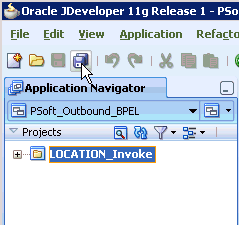
You are now ready to deploy the BPEL outbound process.
Perform the following steps to deploy the BPEL outbound process.
Right-click the project name in the left pane (for example, LOCATION_Invoke), select Deploy, and then click LOCATION_Invoke.
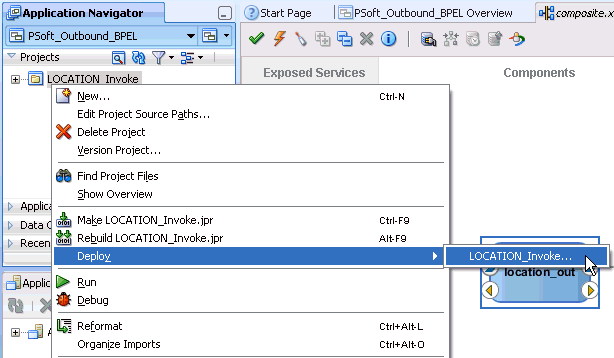
The Deployment Action page is displayed.
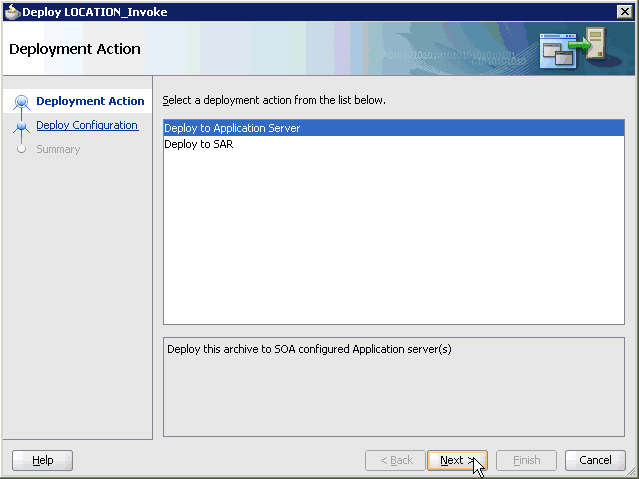
Ensure that Deploy to Application Server is selected.
Click Next.
The Deploy Configuration page is displayed.
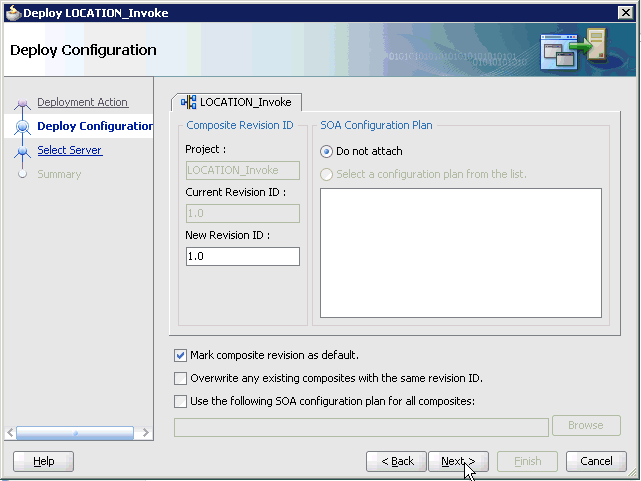
Leave the default values selected and click Next.
The Select Server page is displayed.
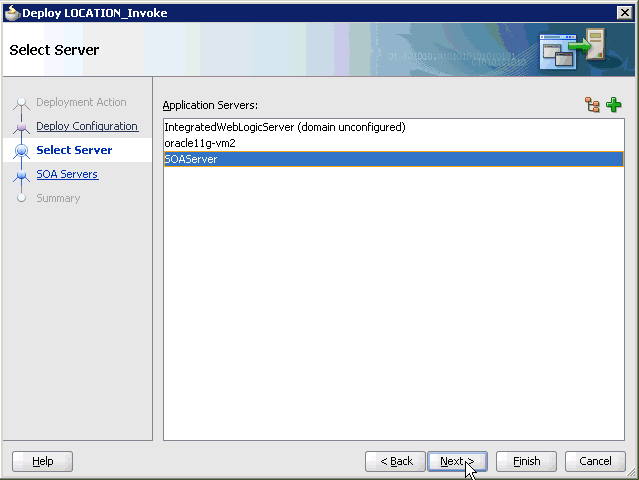
Select an available application server that was configured and click Next.
The SOA Servers dialog is displayed.
Select a target SOA server and click Next.
The Summary page is displayed.
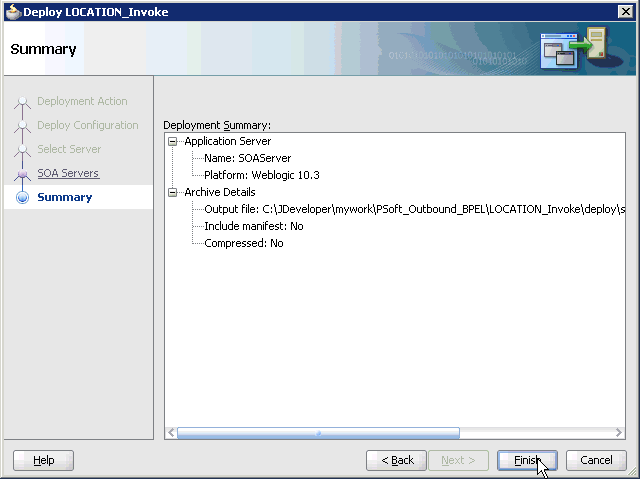
Review and verify all the available deployment information for your project and click Finish.
The process is deployed successfully.

If an Authorization Request dialog is displayed during the deployment process, provide the required user name and password and click OK.
Perform the following steps to invoke the input XML document in the Oracle Enterprise Manager console.
Log in to the Oracle Enterprise Manager console by using the following URL:
http://localhost:7001/em
Expand your domain in the left pane followed by the SOA folder.
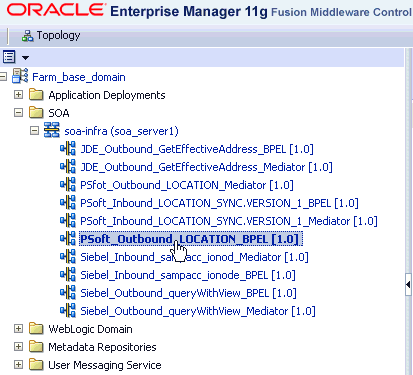
Select an available project (for example, PSoft_Outbound_LOCATION_BPEL).
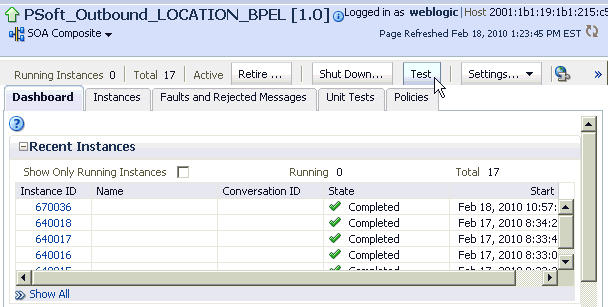
Click Test in the right pane.
The Test Web Service page is displayed.
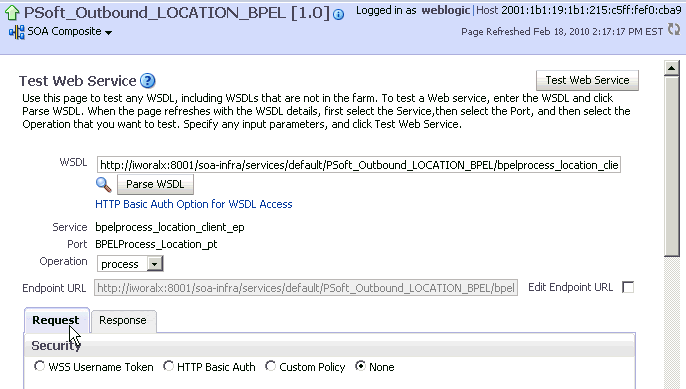
Click the Request tab.
Scroll down to the Input Arguments section.
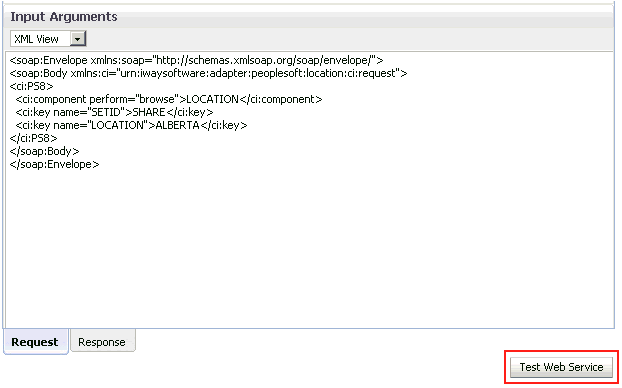
Select XML View from the list in the upper-left corner.
Provide an appropriate input XML document in the Input Arguments area.
For example:
<soap:Envelope xmlns:soap="http://schemas.xmlsoap.org/soap/envelope/"><soap:Body xmlns:ci="urn:iwaysoftware:adapter:peoplesoft:location:ci:request"><ci:PS8> <ci:component perform="browse">LOCATION</ci:component> <ci:key name="SETID">SHARE</ci:key> <ci:key name="LOCATION">ALBERTA</ci:key></ci:PS8></soap:Body></soap:Envelope>
Click Test Web Service.
The output response is received in the Response tab of the Oracle Enterprise Manager console.
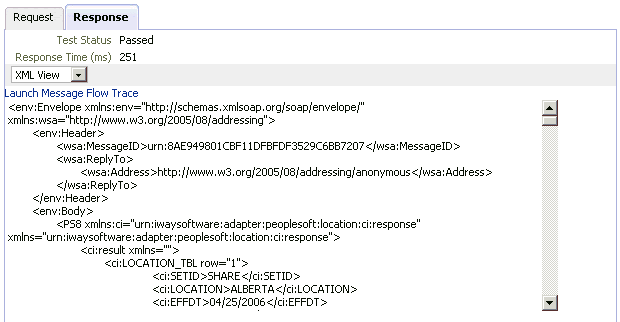
When testing an outbound BPEL process or an outbound Mediator process from the Oracle Enterprise Manager console, do not use the XML envelopes that are generated by these consoles. Instead, remove them and use the XML payloads that are generated from the schemas, which conform to the WSDLs for namespace qualifications.
The Mediator data flows can be tested using the Oracle Enterprise Manager console. When creating a Mediator data flow and interactions, the Web services are created and registered with the Oracle WebLogic Server. For more information on creating a Mediator outbound process, see Chapter 5, "Integration With Mediator Service Components in the Oracle SOA Suite".
This section demonstrates how Oracle Application Adapter for PeopleSoft integrates with PeopleSoft to receive event data. In this example, an PeopleSoft event occurs when a customer record is added to a PeopleSoft system.
The following tools are required to complete your adapter design-time configuration:
Oracle Adapter Application Explorer (Application Explorer)
Oracle JDeveloper BPEL Designer (JDeveloper) or Eclipse
Note:
The examples in this chapter demonstrate the use of JDeveloper.Before you design a BPEL process, you must generate the respective WSDL file using Application Explorer. See "Generating WSDL for Event Integration" for more information.
You must create a separate channel for every event and select that channel when you generate WSDL for inbound interaction using Application Explorer.
Note:
If two or more events share the same channel, event messages may not be delivered to the right BPEL process.Creating a Channel
To create a channel:
Click the Events node.
Expand the PeopleSoft node.
The ports and channels nodes appear in the left pane.
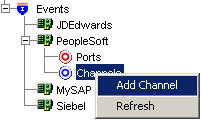
Right-click Channels and select Add Channel.
The Add Channel dialog is displayed.
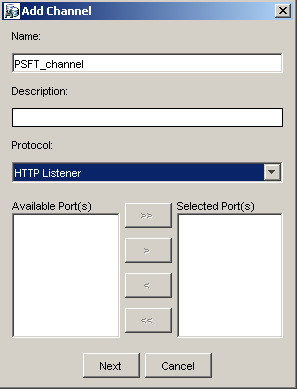
Provide the following information:
Enter a name for the channel, for example, PSFT_Channel.
Enter a brief description (optional).
From the Protocol list, select HTTP Listener.
Click Next.
When the HTTP listener dialog is displayed, enter the system information as specified in the following table:
| Parameter | Description |
|---|---|
| Listener port | Port on which to listen for PeopleSoft event data. |
| Https | For a secure HTTP connection, select the Https check box. |
| Synchronization Type | Choose from the following synchronization options:
Important: The PeopleSoft channel does not work if the synchronization type is set to REQUEST. |
Click OK.
The channel appears under the channels node in the left pane. An X over the icon indicates that the channel is currently disconnected.
Generating WSDL for Event Notification
After you create a channel and verify that it is not started, you must generate WSDL for the event using Application Explorer.
Start Application Explorer.
Expand PeopleSoft.
Click a target name under the PeopleSoft node, for example, PSFTtarget.
Verify your connection parameters and provide the required password.
Right-click the target name and select Connect.
The x icon disappears, indicating that the target is connected.

Expand Messages and select LOCATION_SYNC.VERSION_1.
Right-click LOCATION_SYNC.VERSION_1.

Select Create Inbound JCA Service (Event).
The Export WSDL dialog is displayed.
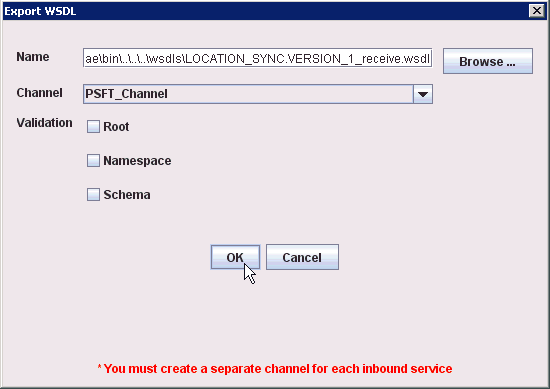
Perform the following steps:
In the Name field, specify the name of the WSDL file.
The .wsdl file extension is added automatically. By default, the names of WSDL files generated for request-response services end with _receive.
From the Channel list, select the channel you created for this inbound service.
Important: You must create a separate channel for every event. Verify that the channel is stopped before run-time.
Three check boxes for Root, Namespace, and Schema validation are also available. Selection of multiple validation options is allowed.
- Root validation is used to validate the root element in the inbound XML document.
- Namespace validation is used to validate the namespace in the inbound XML document.
- Schema validation is used to validate the inbound XML document with the schema in the WSDL document.
During run time, validation is processed based on the validation options that are selected. If more than one validation option is selected, during run time if the first validation option fails, the remaining validation options are not processed. Root and namespace validations are considered modest levels of validation. Schema validation is a stricter validation level. It is recommended to use root and namespace validation options together, unless the root element and namespace are different between the Messages in the PeopleSoft environment.
You can now create a new SOA application, which is the first step that is required to define a BPEL inbound process in JDeveloper.
Perform the following steps to create a new SOA application for the inbound BPEL process:
Open Oracle JDeveloper on your system.
In the Application Navigator tab, click New Application.

The Create SOA Application wizard is displayed.
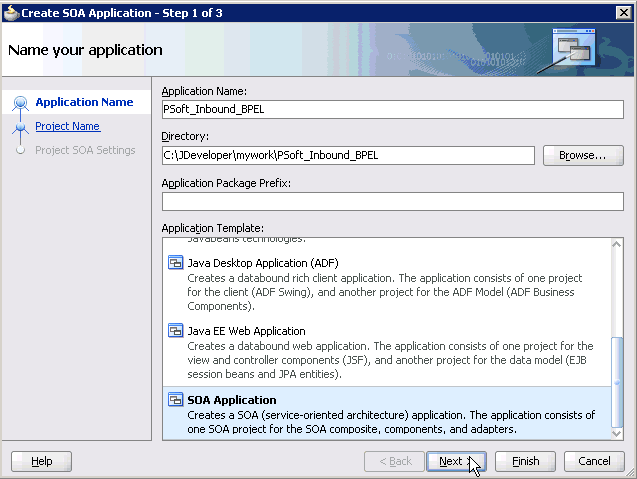
From the Application Template list, click SOA Application.
Enter name for the new SOA application (for example, PSoft_Inbound_BPEL) and click Next.
The Name your project page is displayed.
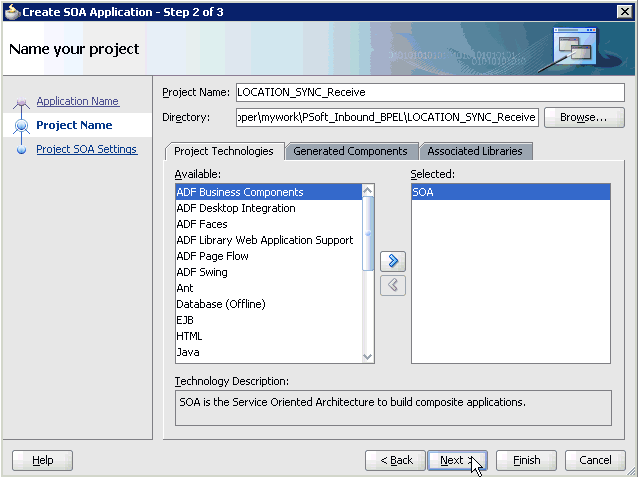
Enter a project name (for example, LOCATION_SYNC_Receive) and click Next.
The Configure SOA settings page is displayed.
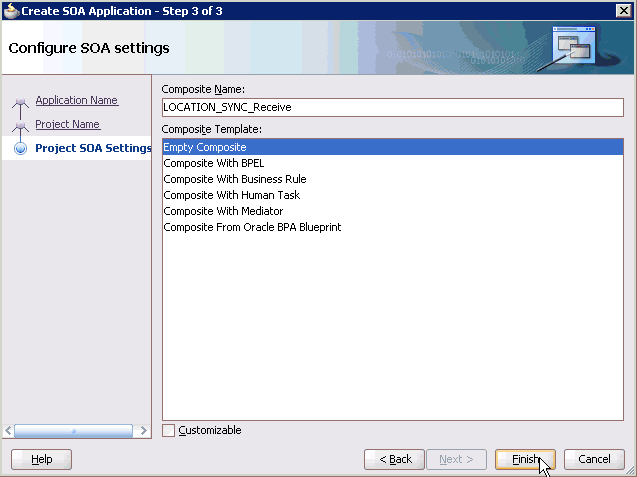
From the Composite Template list, select Empty Composite and click Finish.
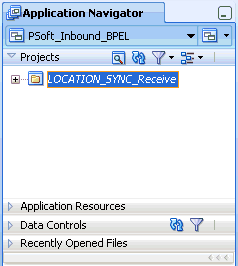
The new SOA application (PSoft_Inbound_BPEL) and associated project (LOCATION_SYNC_Receive) are added to the Application Navigator tab in the left pane.
This section describes how to define a BPEL inbound process, which consists of the following stages:
Configuring a Third Party Adapter Service Component
Configuring an Inbound BPEL Process Component
Creating a Third Party Adapter Service Component
Perform the following steps to create a third party adapter service component:
Drag and drop the Third Party Adapter component from the Component Palette tab (Service Adapters section) to the Exposed Services pane.
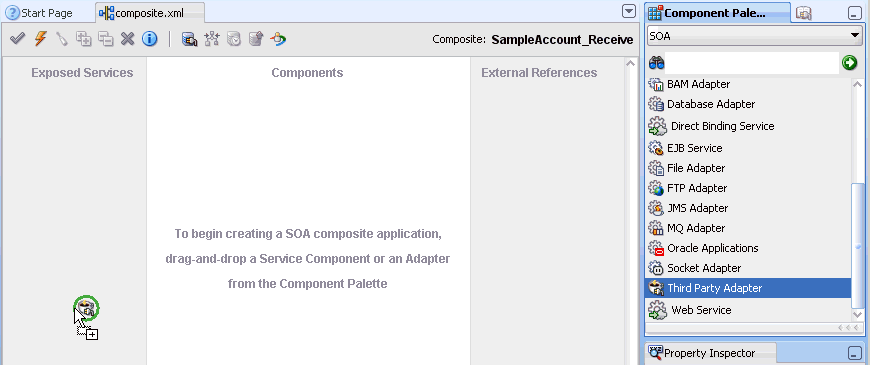
The Create Third Party Adapter Service dialog is displayed.
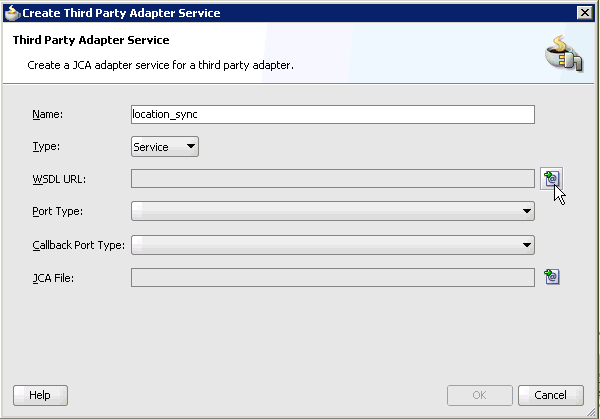
Enter a name for the third party adapter service.
Ensure that Service is selected from the Type list (default).
Click the Find existing WSDLs icon, which is located to the right of the WSDL URL field.
The SOA Resource Browser dialog is displayed.
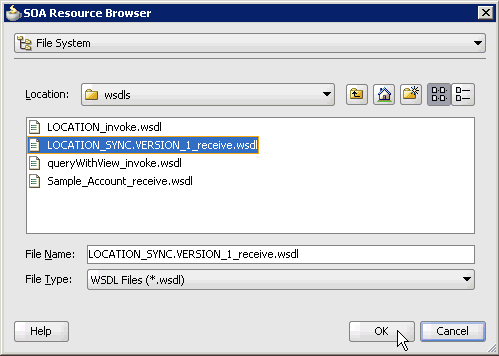
Browse and select an inbound WSDL file (for example, LOCATION_SYNC.VERSION_1_receive.wsdl) from the following directory:
C:\oracle\Middleware\home_GA\Oracle_SOA1\soa\thirdparty\ApplicationAdapters\wsdls
Click OK.
The Localize Files dialog is displayed.
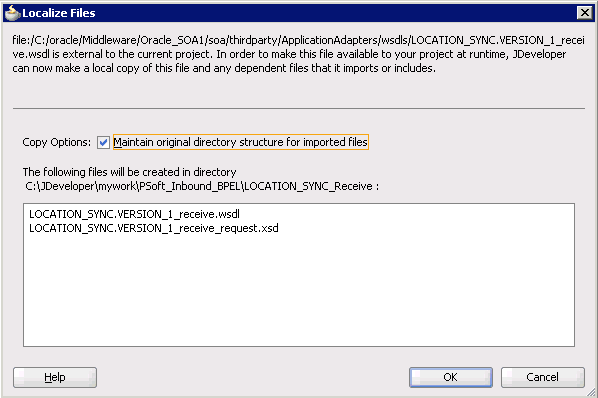
Click OK.
The inbound WSDL file and associated receive/request XML schema file (.xsd) are imported to the project folder that has been created.
You are returned to the Create Third Party Adapter Service dialog.
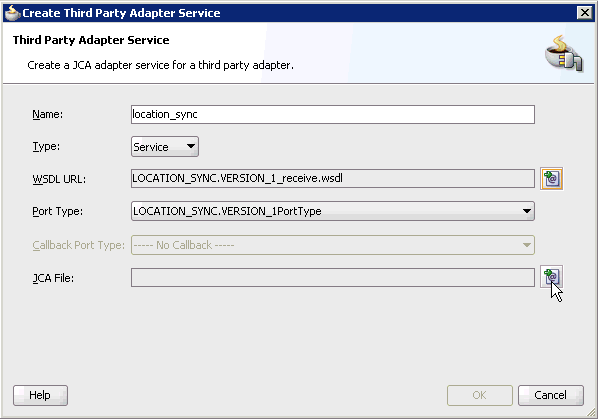
Click the Find JCA Files icon, which is located to the right of the JCA File field.
The SOA Resource Browser dialog is displayed.
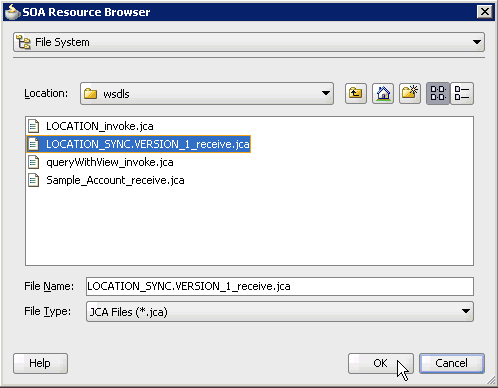
Browse and select the JCA properties file (for example, LOCATION_SYNC.VERSION_1_receive.jca)from the following directory:
C:\oracle\Middleware\home_GA\Oracle_SOA1\soa\thirdparty\ApplicationAdapters\wsdls
Click OK.
The following message is displayed.
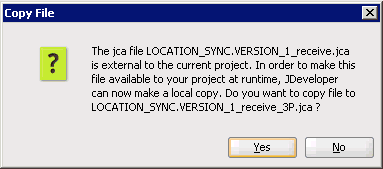
Click Yes.
A copy of the JCA properties file is made in the project folder.
You are returned to the Create Third Party Adapter Service dialog.
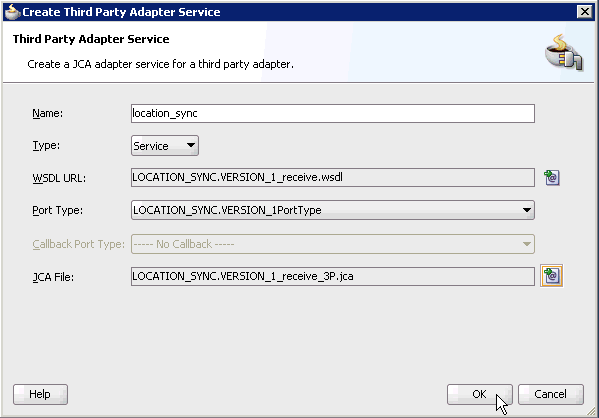
Click OK.
The third party adapter service component (location_sync) is created in the Exposed Services pane, as shown in the following image.
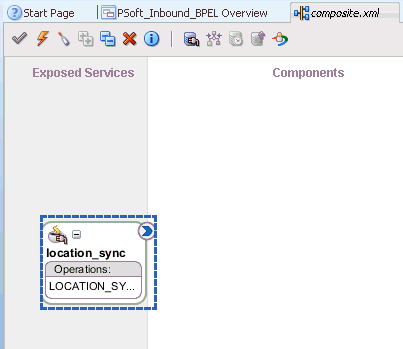
You are now ready to configure an inbound BPEL process component.
Creating an Inbound BPEL Process Component
Perform the following steps to create an inbound BPEL process component:
Drag and drop the BPEL Process component from the Component Palette tab (Service Components section) to the Components pane.
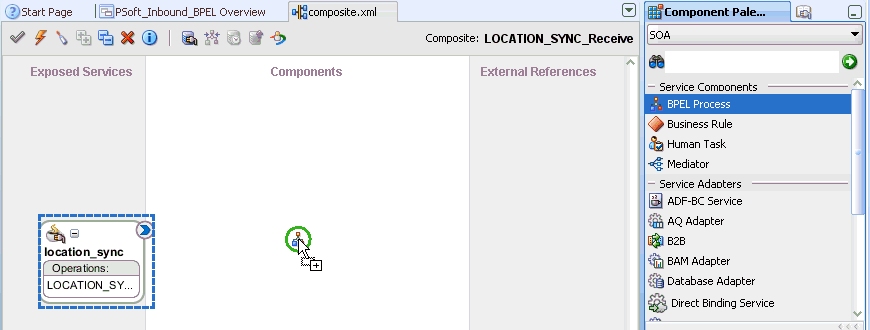
The Create BPEL Process dialog is displayed.
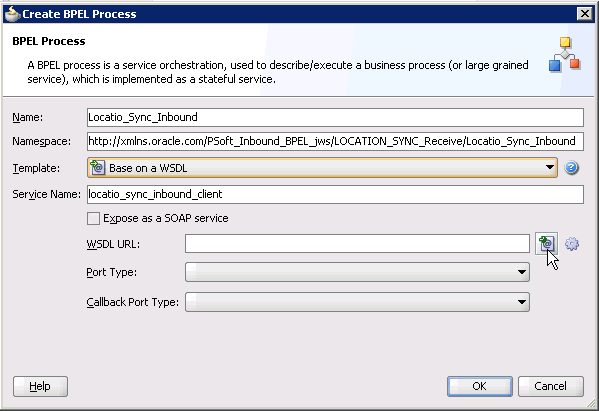
In the Name field, enter a name to identify the new inbound BPEL process component (for example, Location_Sync_Inbound).
From the Template list, select Base on a WSDL.
Uncheck the Expose as SOAP service check box.
Click the Find existing WSDLs icon, which is located to the right of the WSDL URL field.
The SOA Resource Browser dialog is displayed.
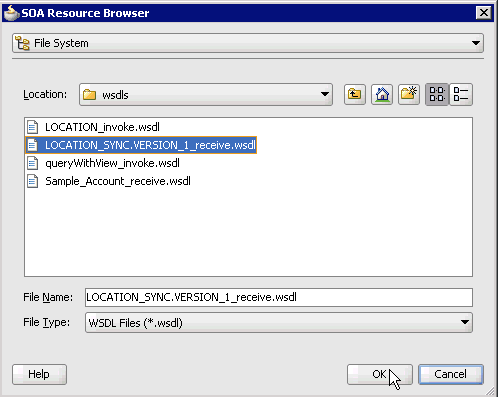
Browse and select an inbound WSDL file (for example, LOCATION_SYNC.VERSION_1_receive.wsdl) from the project folder.
Click OK.
The Localize Files dialog is displayed.
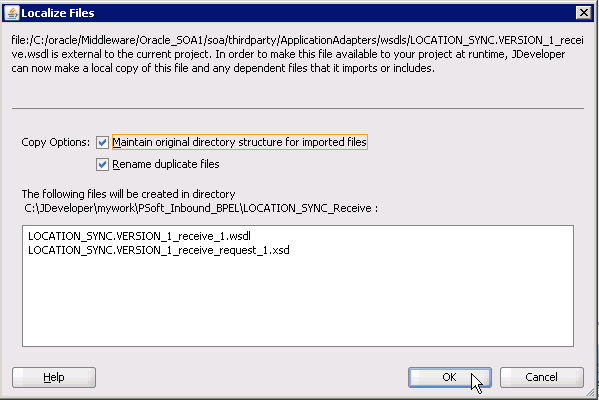
Click OK.
You are returned to the Create BPEL Process dialog.
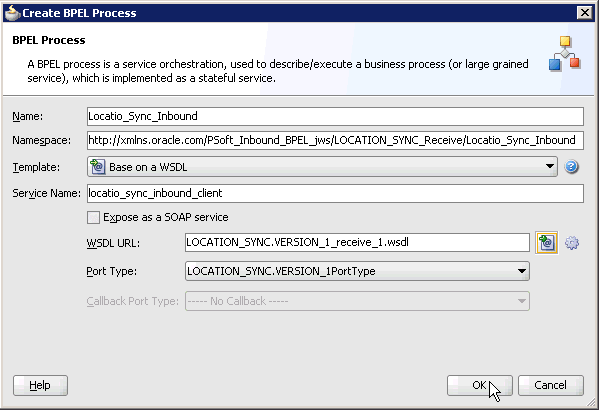
Click OK.
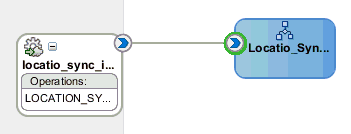
Create a connection between the third party adapter service component (location_sync) and the inbound BPEL process component (Location_Sync_Inbound).
Double-click composite.xml in the left pane.
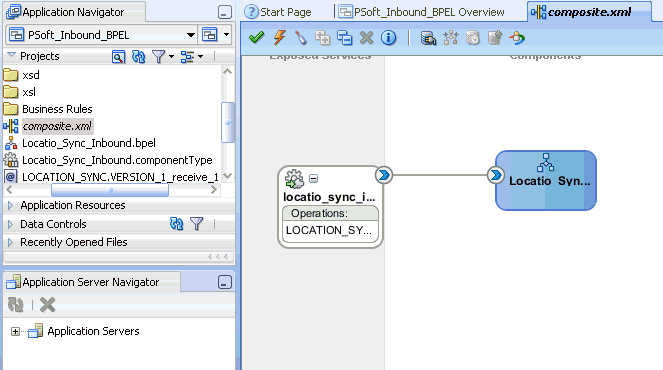
Click the Save All icon in the menu bar to save the new inbound BPEL process component that was configured.
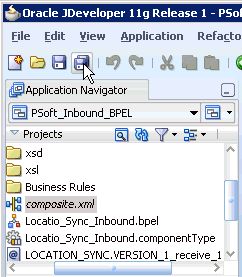
You are now ready to deploy the BPEL inbound process.
Perform the following steps to deploy the BPEL inbound process.
Right-click the project name in the left pane (for example, LOCATION_SYNC_Receive), select Deploy, and then click LOCATION_SYNC_Receive.
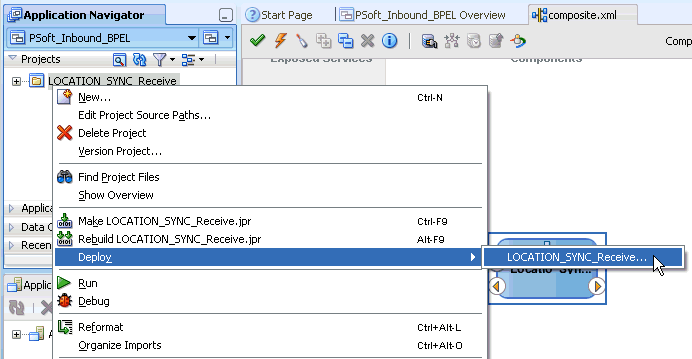
The Deployment Action page is displayed.
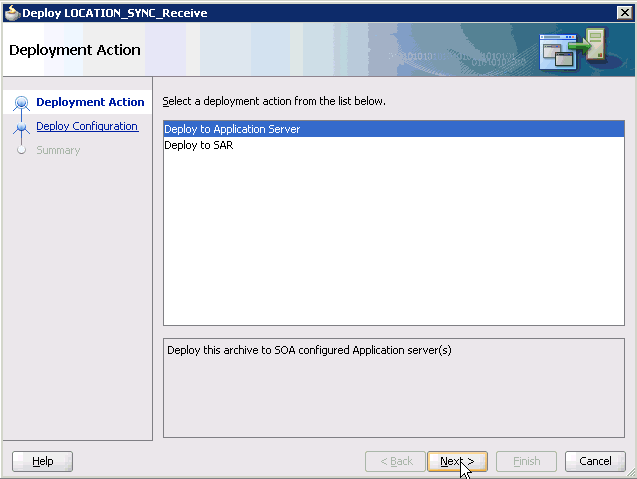
Ensure that Deploy to Application Server is selected.
Click Next.
The Deploy Configuration page is displayed.
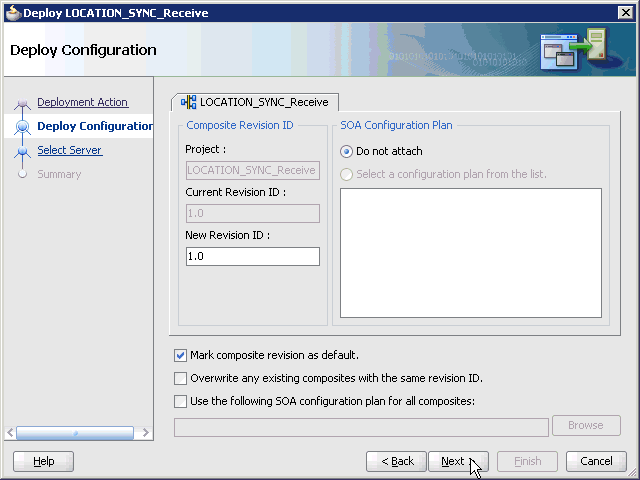
Leave the default values selected and click Next.
The Select Server page is displayed.
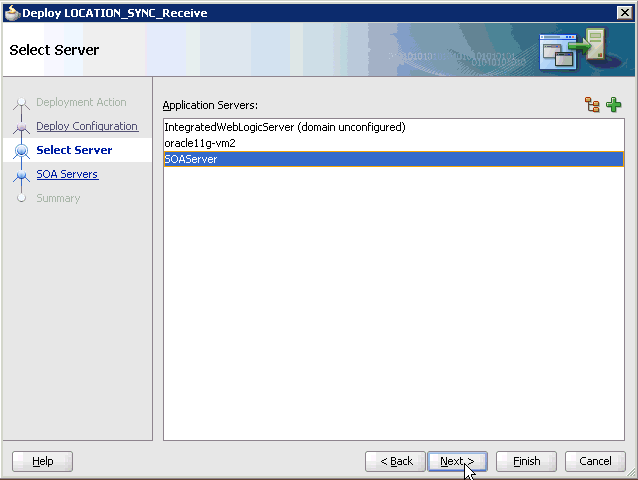
Select an available application server that was configured and click Next.
The SOA Servers dialog is displayed.
Select a target SOA server and click Next.
The Summary page is displayed.
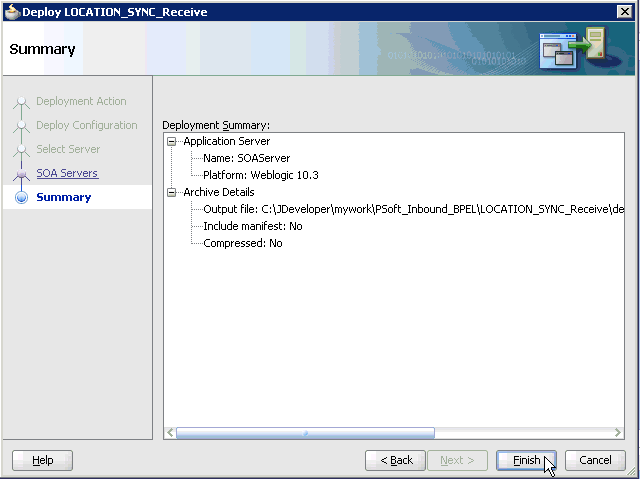
Review and verify all the available deployment information for your project and click Finish.
The process is deployed successfully.

If an Authorization Request dialog is displayed during the deployment process, provide the required user name and password and click OK.
Once event messages are triggered through PeopleSoft, successful instances are received in the Oracle Enterprise Manager console.
Events are generated by activity in an application system. For example, PeopleSoft may generate an event as customer information is updated in the system. The following topics describe how to trigger an event in PeopleSoft and verify the event using Oracle Application Adapter for PeopleSoft.
To trigger an event in PeopleSoft:
Log in to PeopleSoft, select PeopleTools, Integration Broker, and then Node Definitions.
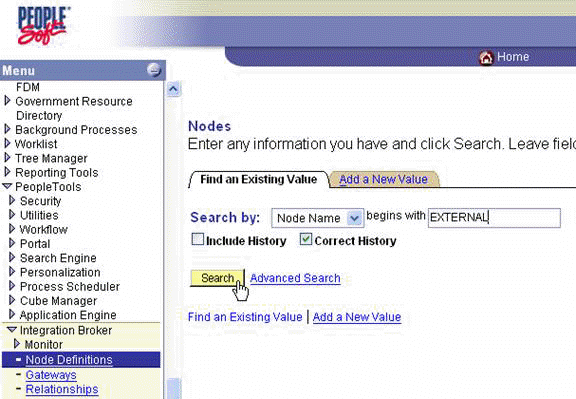
Enter the node name you are using, for example, EXTERNAL; then click Search.
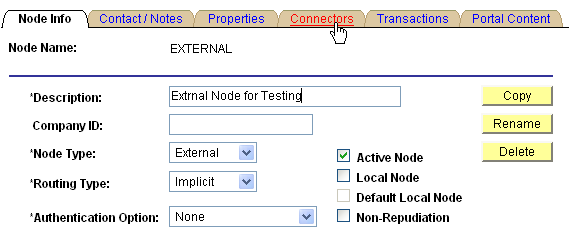
Click the Connectors tab.
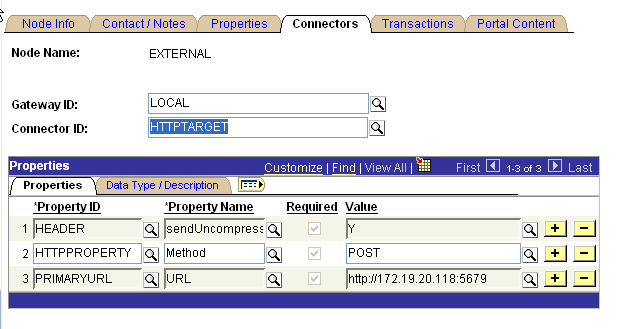
Enter HTTPTARGET in the Connector ID field; then enter the listener URL and its port in the PRIMARYURL field.
To save the configuration, click Save.
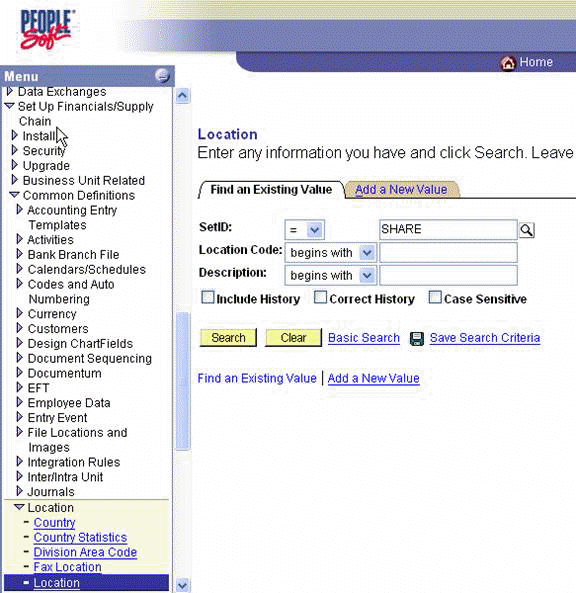
From Menu in the left pane, select Set Up Financials/Supply Chain, Common Definitions, Location, and then Location.
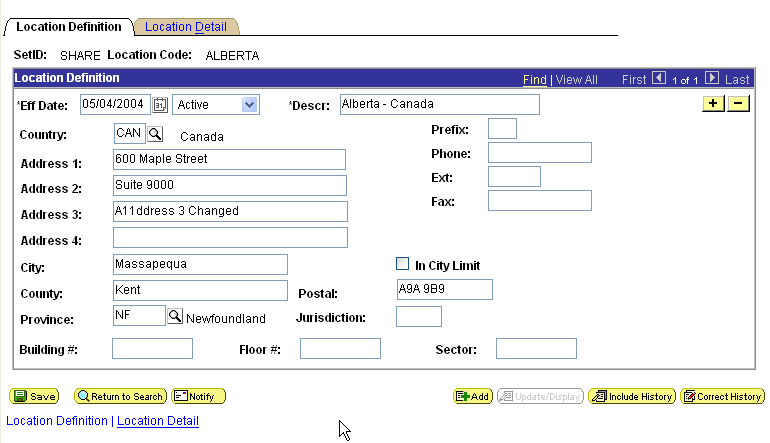
To find the location record you want to update, click Search; then make the changes and click Save.
When the change is saved, it triggers an event and sends the event to the listener.
Verifying the Results
To verify your results:
Log in to the Oracle Enterprise Manager console by using the following URL:
http://localhost:7001/em
Expand your domain in the left pane followed by the SOA folder.
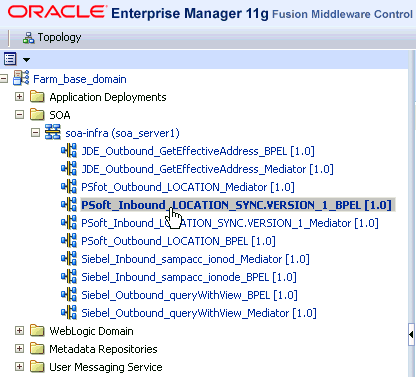
Select an available project (for example, PSoft_Inbound_LOCATION_SYNC.VERSION_1_BPEL).
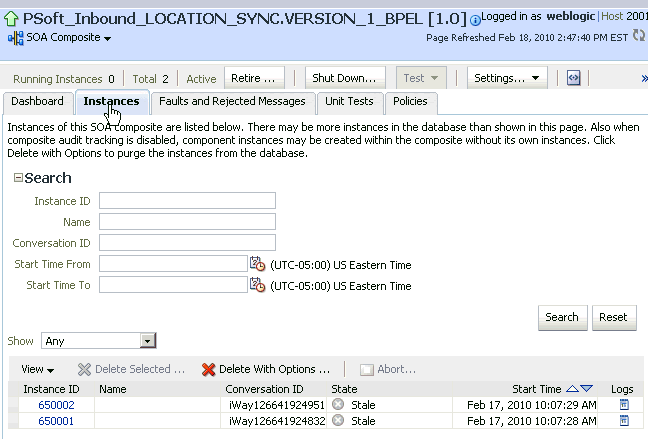
Click the Instances tab in the right pane.
Recently received run-time events are displayed in the Instances tab.

Select a PeopleSoft instance ID.
The Flow Trace page is displayed.
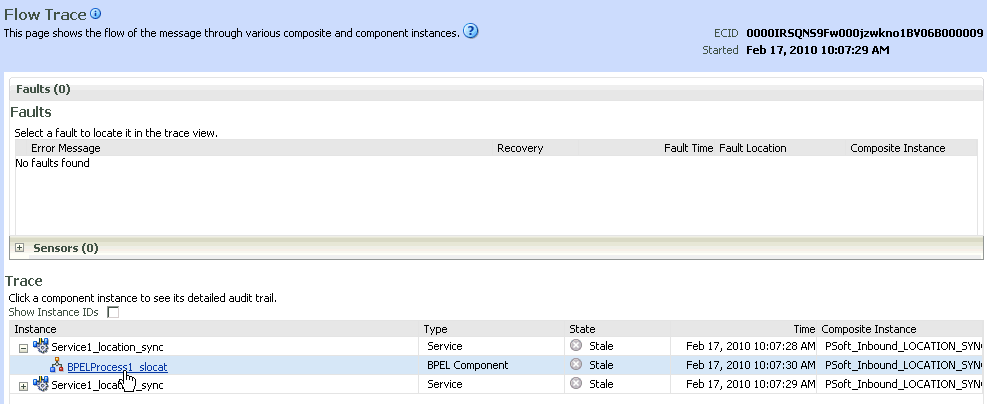
Select a component instance to view its detailed audit trail.
The Instance page for the selected component is displayed.
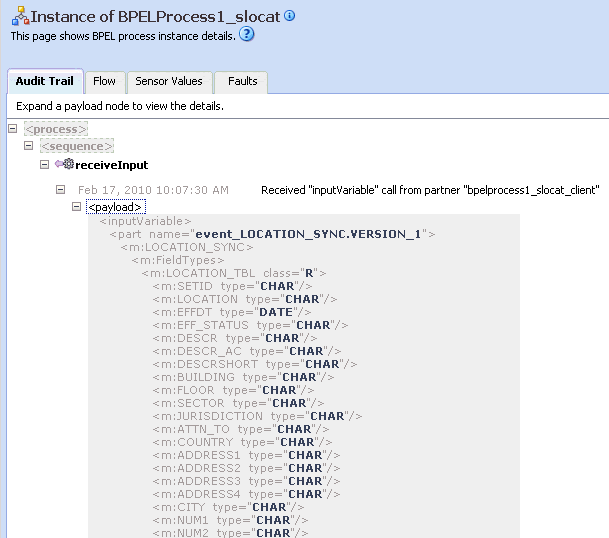
Click the Audit Trail tab to view the event message.
The message received from the PeopleSoft system is displayed in the Audit Trail tab.